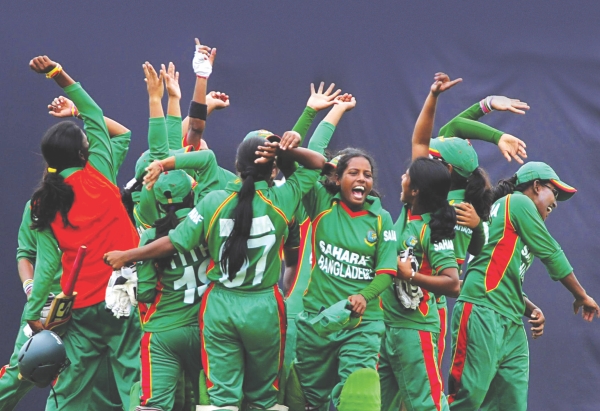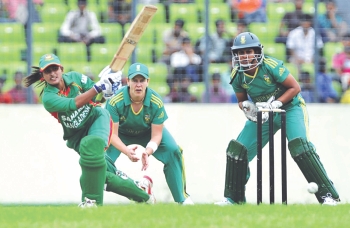| Home - Back Issues - The Team - Contact Us |
 |
| Volume 11 |Issue 37| September 21, 2012 | |
|
|
Sport
Women's Cricket Naimul Karim As it so often happens, the ongoing frenzy about the men's Twenty 20 world cup preparations has overshadowed the Bangladeshi women's cricket team's progress. The three T20 tours which were organised for the men's team, against cricketing nations that one can ideally term as below-par– considering the fact that a weakened South African side was their strongest match– dominated media proceedings. One can't ideally question the role that the media took; after all the 'Men in Green' are perhaps the only known sporting icons that the younger generation would want to emulate. There were, however, a number of 'mini-achievements' of sorts in the recently concluded series in Dhaka, between the Bangladeshi women's cricket team and their South African counterparts that were overlooked. While the hosts did lose both the One Day International and Twenty 20 tournaments, their body language on the field and the way they battled against a unit that was more professional and more experienced, showed several positive indications. Perhaps the most heartening aspect of the entire series was to see a near full stadium in the third and final T20 game, a visual, in the words of President of the BCB, Mustafa Kamal, which you don't get to see 'anywhere else in the world.' Mignon Du Preez, the South African captain echoed Kamal's reaction. In a post-match interview, she stated that playing in front of an audience gave them the perfect warm-up before the upcoming T20 world cup in Sri Lanka, where the South Africans are pitted against the hosts. "I know that the crowd didn't exactly come to support us, but it feels good to have an audience. We aren't used to this back home," she said.
The fact that nobody was charged to enter the stadium doesn't take anything away from the cricketers. The celebratory atmosphere after Salma Khatun, the captain of the Bangladeshi side, batted her team out of trouble in the first T20 game, and helped the home side coast to victory, resembled that of Bangladesh's (Men's team) first series win against Zimbabwe. It was the hope of winning a series against a higher ranked cricketing nation that brought thousands into the ground in the deciding game. Unfortunately, as it so happened, the home side crumbled under pressure and failed to chase down a below-par total of 85 runs. While they ended up losing the series by two games to one, the signs of progress, however, are extremely positive. The current cricketing side, to a certain extent, reminds you of the men's cricket team of the early days, when they initially got their ODI status. The team has repeatedly shown their ability with the ball, but fails to succeed in the batting and fielding departments. And the final game, where the home side was bundled out for 70 odd runs, reflected exactly that. While the near-miss did disappoint the Bangladeshi players, it did, instil in them, a new belief. A belief that can help them progress and maybe even help them break through the elite group of cricketing nations. Funnily enough, the women's team's progress can be measured based on the number of times that they actually cleared the ropes in the series. A disappointing ODI series against the Proteas didn't see any sixes from the bat of a Bangladeshi. The T20 series, where Bangladesh fought neck and neck with the visitors, saw two sixes and a number of boundaries. A statistic which shows that, if this side gains confidence, they can actually move up the ranks. But this of course is just the beginning. Players like Lata Mondol, Ayesha Rahman and Salma Khatun have steadily moved up the ranks and have developed their skills in the last couple of years. Attracting more players to the game and expanding the pipeline is a challenge that the BCB has to overcome. The problem was stated by the team's new coach, Oshadee Weerasinghe, at the end of the T20 series last week. "We need more players. I can't do much with a group of 20 players in the team," he said. Currently, there are 16 players who have been assigned contracts by the BCB. The number might increase in the upcoming fiscal year, but this aspect of the game needs to progress at a faster rate. The BCB President did say that they were planning to host a fest to attract more women towards cricket and that they'll be hosting several programmes to hunt for players; these plans, however, have been on the blocks for a while now and no one knows when these future programmes are going to take place. Another aspect that needs to be focussed upon is the payment structure. The contractual players' monthly salaries range from Tk 8,000 to 12,000 a month. With such a low pay-scale, one wonders if sporting persons will ever be encouraged to take up cricket as a profession. Despite the many obstacles, it can be said that the women's cricket is on the right track. It's at a point where an increased support from the BCB can actually make a huge difference in the upcoming five years. Until then, cricket would mean tuning in to watch the Men in Green giving it their all on the field, something that we'll all be doing today at 4 pm when the Tigers take on New Zealand in their first T20 game. One hopes that there will come a day when we support the Salmas and the Latas in the same way we go to cheer for the Shakibs and Tamims today.
|
||||
Copyright
(R) thedailystar.net 2012 |

